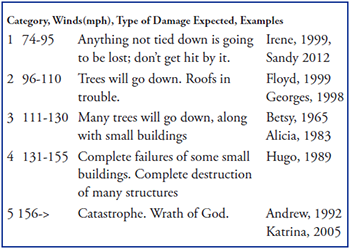VINCENT PICA – COMMODORE, FIRST DISTRICT, SOUTHERN REGION (D1SR) – UNITED STATES COAST GUARD AUXILIARY
Last fall, Superstorm Sandy gave us all a pretty good warning and some of us got a pretty good beating. Almost without exception, we in the Northeast get the tail, shoulder or rump of one or two of the dozen or so hurricanes that form each summer in the Atlantic between the Caribbean. Sandy did most of its damage when it arrived at a flooding spring tide and pushed it higher and higher. Most of us live on an island or along the mainland coast…and hurricane season has just begun. This column is about that.
Tidal surges
As Sandy demonstrated, as bad as the winds are (more on that
below), it’s the tidal surges that do most of the damage. The
storm tide is added to the astronomical tides, and when those
waves hit something solid, they generate force dozens of times
more powerful than wind of the same speed. Sandy generated
a 10-foot tidal surge in places. Andrew, in 1992, generated a
storm tide of 17 feet. Camille in 1969? 24 feet. Add to that
the population growth in our area and the increase in home
values, and it can spell either “an absolute disaster” or “they were
prepared.”
What is it?
A hurricane is, in the words of scientists, an organized rotating
weather system that develops in the tropics. Technically, it’s
a “tropical cyclone” and classified as one of three states, with
hurricanes being further classified into levels of destruction.
Tropical Depression: sustained winds of 38 mph (33 knots) or less
Tropical Storm: sustained winds of 39 to 73 mph (34-63 knots)
Hurricane: sustained winds of 74 mph (64 knots) or greater
Hurricanes are called typhoons in the western Pacific and
cyclones in the Indian Ocean. Six of one, a half-dozen of the
other…
Categories of hurricanes
We’ve all heard the weather reporter state that “Hurricane ‘x’ is
now a Category 3 hurricane and headed for ________.” What
does that mean?

USCG hurricane aircraft reported Andrew and Katrina had
generated winds over 200mph at various times.
Are you ready for the glancing blow?
Look, if a Category 4 or 5 gets up here like in 1938, there are
no levels of preparedness except evacuation. A storm surge like
Camille’s basically means that everything “south of the highway,”
as real estate agents like to classify the choicest properties on
Long Island, is gone for all intents and purposes. The Gold
Coasts, on both sides of Long Island Sound, will be flattened.
But what if the glancing blow like Ivan’s in 2004 or, Earl, who
came by earlier in 2012, came in head-on? How can you be
ready?
Before the storm arrives
- Have a family action plan – if you’re at caught at school or at work, who do you call?
- Flashlights working? Canned goods and water supplies? Cash? Portable radio?
- Where ARE you going to move the boat? Don’t even THINK about staying on her…(more on that next month!)
- How about your prescription medicines? A first-aid kit is WHERE…?!
During the storm
- Have the radio or TV on. If power goes out and you don’t have a portable radio, I’d get the kids in the car and “to grandmother’s house we go…!”
- Propane tanks on your property? Shut them off, completely.
- Turn the refrigerator up all the way and don’t open the door idly.
- Fill the bathtub with water. How about the big spaghetti pot? Anything that can hold water and keep it clean.
- If ordered to evacuate, do so. Immediately. And tell someone where you are going.
- When evacuating, don’t drive across flowing water. Two feet of flowing water can carry your car away. Yes, only two feet of moving water. Turn around and go another way. If there is no other way, call 9-1-1 or the US Coast Guard.
After the storm
- If you’ve been ordered to evacuate, don’t go back until the area is declared safe.
- If you see someone that needs rescuing, unless the threat of loss of life is imminent, call 9-1-1.
- See standing water? Do you know if any power cables lie in it?
- Never use candles and other open flames indoors. Keep the flashlight at your side.
This is by no means an exhaustive list. But Sandy just sent us a wake-up call.
Captain Joe Vojvodich is the Captain of the Port and Sector Commander for US Coast Guard Sector Long Island Sound. Captain Vojvodich is responsible for all active-duty, reservist and auxiliary Coast Guard personnel within the Sector. Vin Pica, a Commodore for the First District Southern Region in the US Coast Guard Auxiliary, works closely with Captain Vojvodich and his staff to promote boating safety in the waters between Connecticut, Long Island and 200 nautical miles offshore. Sector Long Island Sound Command Center can be reached 24 hours a day at 203-468-4401.




